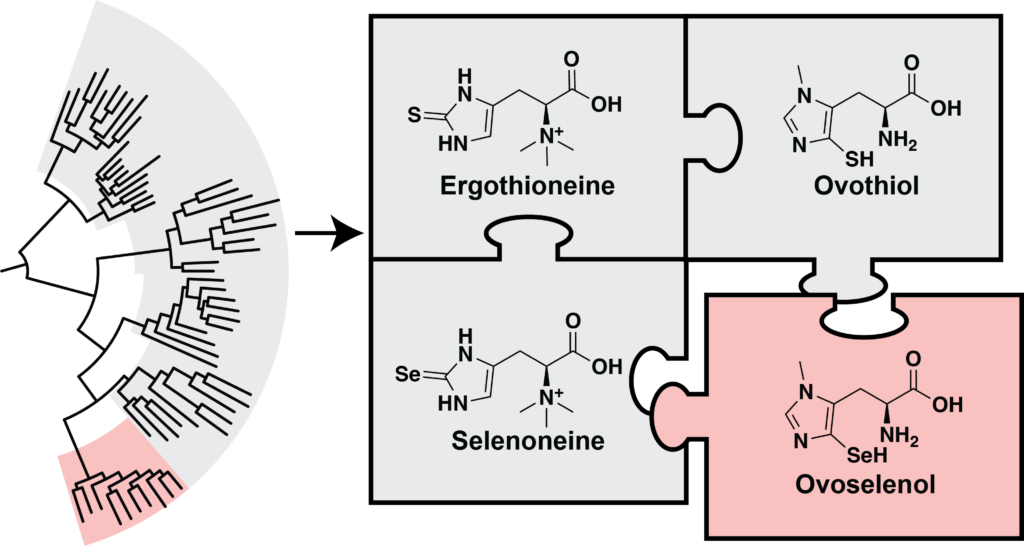Mo Lab expands selenometabolome with the discovery of ovoselenol
The Seyedsayamdost Lab announces the discovery of a novel selenometabolite and potential antioxidant that, together with their 2022 research published in Nature, signals the existence of an uncharted selenometabolome.
The lab also upends for the second time in two years the long-held notion that enzymes only install selenium into large molecules, like proteins and nucleic acids. They describe another pathway for selenium insertion into small molecules by a specialized class of enzymes.
Their research suggests a deeper biological significance for selenium, a trace micronutrient that is essential for an organism’s growth and metabolism but toxic at high levels.

The lab’s paper, Discovery of the selenium-containing antioxidant ovoselenol derived from convergent evolution, out this week in Nature Chemistry, introduces the selenometabolite ovoselenol. The researchers characterize it as part of an emerging and intriguing class of biomolecules.
“We’re shifting away from the old paradigm about selenium to one that says maybe it is more prevalent in biology than people previously thought. And we are excited by that,” said Chase Kayrouz, lead co-author on the paper and a graduate student in the Mo Lab. “In our field, we don’t look for macromolecules, we look for small molecules. And since selenium is a trace element, you’ll never find it unless you’re actually looking for it. We basically just looked under the right rock.
“The takeaway is that these metabolites are out there.”
Professor of Chemistry Mohammad Seyedsayamdost said the discovery provides proof of a selenometabolome. A metabolome is a collection of small molecules required for cellular maintenance and function. “It has been known for some time that cells can incorporate selenium into large biopolymers. We asked, are there pathways that insert this element into small molecules, the kinds that are found in primary and secondary metabolic pathways?
“In our 2022 paper, we reported the first pathway for insertion of selenium into a small molecule. The molecule, selenoneine, was known but it was thought that cells accidentally incorporate selenium in place of sulfur to generate it. Our work showed that nature has evolved entirely different pathways for the selenium and sulfur isologs. In the current paper, we are reporting a new pathway and a new selenometabolite, ovoselenol. It further substantiates our idea that there is a larger selenometabolome that can now be mined.”

Professor of Chemistry Mohammad Seyedsayamdost, and lead author on the paper and graduate student Chase Kayrouz.
Kayrouz emphasized that the researchers do not yet know the function of these molecules in their native environments.
“We have promising hints that are going to guide the next steps,” Kayrouz said. “They’re definitely doing something for the producing organisms. But it’s still an open question.”
Princeton researchers collaborated with the Davis Lab out of Emory University on this work, particularly co-lead author Kendra Ireland, who investigated the structure of the new enzyme.
Seeking the relatives
The Mo Lab’s latest paper offers a blueprint for charting future research into the selenometabolome. Their approach is based not on a specific modality but on a way of thinking about this trace element fueled by the concept of convergent evolution.
“The interesting thing about selenium-installing enzymes is that they’re the product of evolution,” said Kayrouz. “So, you can start with the known enzymes and then look for their close relatives. That’s what we did.”
The researchers took these relatives and constructed a phylogenetic tree to visualize how the family evolved, searching for “branches” that could represent distant relatives that evolved recently from the known enzymes. These were suspected to catalyze new reactions. The lab then zeroed in on one of these new branches by producing that enzyme in the laboratory and characterizing its function.
“To our delight, we found that this enzyme installs a unique carbon-selenium bond on route to a novel selenometabolite, ovoselenol,” Kayrouz said. “Another thing we’ve confirmed over the years is that while we think there is more to discover, it’s not everywhere. You really have to look in some niche places to find selenium. They represent a very specialized set of compounds. It’s still very much a needle in the haystack process.”
By measuring the electrochemical properties of ovoselenol, the researchers found it to be an excellent reductant, suggesting it may have a heightened role as an antioxidant with conceivable therapeutic applications.
These attributes will provide the lab with new motivation for looking into the molecule in future investigations.
“Selenium has chemical properties that make it a little difficult to control,” said Seyedsayamdost. “The enzymes that have evolved to introduce carbon-selenium bonds can manage or tame the properties of selenium. These enzymes could serve as useful biocatalysts to incorporate this element into all kinds of small molecules, and that is another direction of future research for us and the field.”
Funding for this research was provided by the National Science Foundation (Graduate Research Fellowship Program no. 1937971 and NSF CAREER award no. 184786), the National Institutes of Health (grant R35 GM147557 and grant R01 GM140034), and the Eli Lilly-Edward C. Taylor Fellowship in Chemistry.
